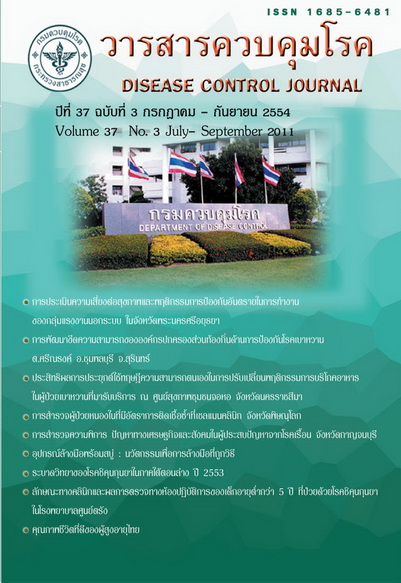A Survey on Disability, Economic and Social Problem of Leprosy affected Persons in Kanchanaburi Province
Abstract
The objective of this study was to survey disability status, socio-economic problems, and their related factors of people affected by leprosy and others residing in communities of Kanchanaburi province. Rapid Disability Assessment toolkit was used in data collecting. Descriptive statistics were used to describe the basic features of the data while Independent - Sample T - Test, One - Way ANOVA, Pearson's product moment correlation coefficient, and Stepwise multiple regression analysis were used for analyzing purposes. It was found that people affected by leprosy and their peers were similar in terms of general characteristics but different in terms of employment and debts. Most members of these two groups had neither activity limitation nor social participation. More than half of people affected by leprosy had perceived stigma but had no experiences of being discriminated by others. Predictive factors for activity limitation of people affected by leprosy were grade 2 disability status, unemployment, low secured house, and having income between 2,000-5,000 baht per month. Predictive factors for activity limitation of peers were age of over 61 years and using more than 2 kinds of disability aids. Predictive factors for social participation of people affected by leprosy were grade 2 disability status and unemployment while those for general population were illiteracy and unemployment. Regarding the attitudes of community members towards leprosy, most of them perceived that leprosy negatively affected people's lives at middle level. Predictive factors of community's attitudes towards leprosy were illiteracy or low education, and having more than 5 family members. The group of people with these characteristics had statistic significantly more negative attitudes towards leprosy than the others. Therefore; prevention of disability and rehabilitation services are still needed to reduce remain problems for reasonable quality of life.
Downloads
Downloads
Published
How to Cite
Issue
Section
License
Articles published in the Disease Control Journal are considered as academic work, research or analysis of the personal opinion of the authors, not the opinion of the Thailand Department of Disease Control or editorial team. The authors must be responsible for their articles.


.png)



